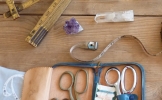Unless you’ve had your mid-career retrospective at the Guggenheim, getting media attention means that you’d better have a compelling story. Local non-art media will feature you even if your art is poorly executed or if you haven’t been an artist for long. The key to pitching stories that journalists want is having a concept that even people who aren’t very interested in culture can enjoy.
I’m often tempted to start a parody blog about getting media attention called “The Most Newsworthy Art Exhibitions and Artists You’ve Never Heard Of,” featuring fictionalized press releases of outrageous media-grabbing art concepts. However, truth is often stranger than fiction, and this article features two artists whose work is very strange indeed.
About a year ago, an Ohio woman who photographed her diseased dog’s urination patterns was widely featured in the media. The splats and splotches of the dog’s urine trails succeeded in getting media attention and an audience who loved animals and were tickled by the photograph’s leaky content. Below is a video link to an ABC broadcast story.

How To Build an Artist Website
Sign up for our newsletter and get the book How to Build an Artist Website for free!
Wafaa Bilal, an Iraqi-born artist, makes art that attacks uncomfortable social and political territory. Bilal’s work succeeds in getting media attention because it provokes discussion about war, personal space, and surveillance. His current project, 3rdi (pronounced “third eye”) documents the surgical implantation of a video camera in the back of the artist's head so he can have a 24-hour live feed of everything going on behind his back. In this piece, Bilal has struck a collective chord about surgical body implants, cultural paranoia, and the nature of privacy. In 2008, the Chicago Tribune called Bilal’s piece about the Iraqi war, Domestic Tension, "one of the sharpest works of political art to be seen in a long time" and named him 2008 Artist of the Year. Below is a video about 3rdi.
It’s no surprise that John Wayne Gacy’s clown paintings are internationally recognized for their shock value. I am not suggesting that becoming a serial killer is a good art career move, but it does illustrate that mixing notorious acts and art are strange, but media-friendly bedfellows. Getting media attention is a matter of the right concept at the right moment. The quirky art of the dog pee photographer and Bilal's visceral political actions are examples of art works that appeal to the general public. The old press adage, “if it bleeds, it leads,” has always proved accurate.
Tips on Pitching Stories to Journalists
I caution you about making art for the sole purpose of getting the attention of journalists. Unless getting media attention is the underlying concept that drives your aesthetic, everyone will see that you’re sucking up. Lady Gaga once said her artistic concept was the art of fame. Obviously, she has succeeded in pressing the right buttons for getting media attention.
When pitching stories, remember that journalists look for interesting ideas that will sell newspapers and magazines. I believe one's art should spring from a predilection to communicate one's mind/heart/soul in visual terms. Often, this perspective resonates with most people and, in turn, could resonate with a cultural journalist. However, don't stop there. Your work might interest business writers or lifestyle reporters. It might work in a science journal or zoological newletter. Ask yourself if there is any context outside art criticism that would take an interest in your work, process, or imagery.
Tactics for Getting Media Attention
Who’s your favorite journalist? He or she probably shares common interests with you. Look at your work as though it was someone else's and decide how you’d talk to your favorite journalist about this work.
What do your favorite reporters write about? Try and wrap your art's concept around the interests of the reporter you wish to target for a feature article. This will get their attention and may even result in a great new project.
The basic tenet of getting media attention is to have a good story with interesting characters. What’s your story? Who are you as the main character? How is your artwork part of your story? Is there drama? Has something been resolved? If you find out what your story might look like on paper, you may have a great pitch for a story-hungry journalist.




